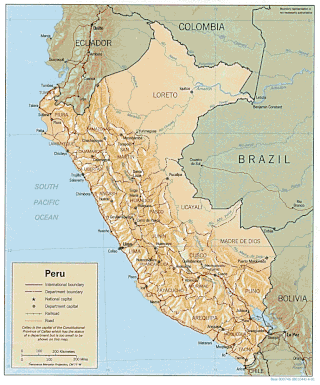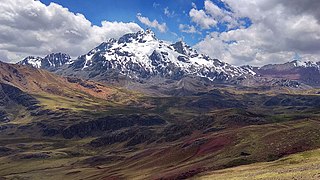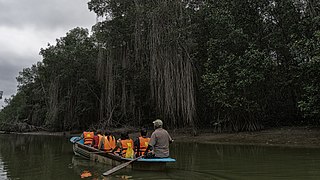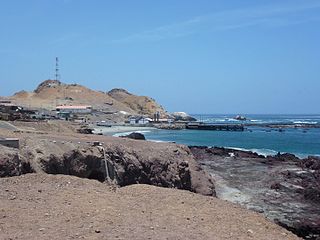
Peru is a country on the central western coast of South America facing the Pacific Ocean. It lies wholly in the Southern Hemisphere, its northernmost extreme reaching to 1.8 minutes of latitude or about 3.3 kilometres (2.1 mi) south of the equator. Peru shares land borders with Ecuador, Colombia, Brazil, Bolivia, and Chile, with its longest land border shared with Brazil.

Junín is a department and region in the central highlands and westernmost Peruvian Amazon. Its capital is Huancayo.

Tumbes is a coastal department and region in northwestern Peru bordering Ecuador. Due to the region's location near the Equator it has a warm climate, with beaches that are considered among the finest in Peru. Despite its small area, the region contains a wide variety of ecosystems. It is the smallest department in Peru and its third least populous department after Moquegua and Madre de Dios, but it is also its third most densely populated department, after La Libertad and Lambayeque.

LachayNational Reserve is a protected area in the region of Lima, Peru. The reserve is located 105 kilometres (65 mi) north from the Peruvian capital, Lima, and protects part of the lomas ecosystem.

Cerros de Amotape National Park is a protected area located in the regions of Piura and Tumbes in northern Peru.

The Chala or "Coast" is one of the eight natural regions in Peru. It is formed by all the western lands that arise from sea level up to the height of 500 meters. The coastal desert of Peru is largely devoid of vegetation but a unique fog and mist-fed ecosystem called Lomas is scattered among hills near the Pacific coast as elevations up to 1,000 metres (3,300 ft).

Junín National Reserve is a protected area located in the region of Junín, Peru. One of its main purposes is to protect the ecosystem and biodiversity of Lake Junín and the surrounding Central Andean wet puna.

Manglares de Tumbes National Sanctuary is a protected natural area located in the region of Tumbes, Peru. Established in 1988, it protects the largest area of mangrove forest in Peru.
Tabaconas-Namballe National Sanctuary is a national sanctuary in Peru established in 1988, and protects the southernmost part of the páramo ecosystem. It is located in San Ignacio Province, Cajamarca and spans an area of 32,124.87 ha.

The Pampas de Ayacucho Historic Sanctuary is located near the town of Quinua in the region of Ayacucho. It has an area of 3 km2 and was established in 1980 to protect the site of the Battle of Ayacucho. Since 2023, it is part of the Bicentenario - Ayacucho Biosphere Reserve.

Cordillera Azul National Park is a protected area in Peru. It protects part of the Ucayali moist forests ecoregion.
El Angolo is a game reserve in northern Peru. It is considered part of the Noroeste Biosphere Reserve, which includes Cerros de Amotape National Park and Tumbes National Reserve, as declared by UNESCO in 1977.
Tumbes National Reserve is a protected area established in 2006 and located in the region of Tumbes, Peru; near the border with Ecuador. It spans an area of 751 km2 (290 sq mi) and along with Cerros de Amotape National Park and El Angolo Game Preserve is part of the Noroeste Biosphere Reserve designated by UNESCO.
Güeppi-Sekime National Park is a protected area located in the Peruvian region of Loreto, on the border with Ecuador. The park encompasses 203,628.51 hectares (2,036 km2) of forests in a landscape that features hills and seasonally flooded lowlands.

The puna grassland ecoregion, part of the Andean montane grasslands and shrublands biome, is found in the central Andes Mountains of South America. It is considered one of the eight Natural Regions in Peru, but extends south, across Chile, Bolivia, and western northwest Argentina. The term puna encompasses diverse ecosystems of the high Central Andes above 3200–3400 m.

Bosque de Pómac Historic Sanctuary is a protected area in Peru located in the region of Lambayeque. This area preserves part of the Tumbes-Piura dry forests and several pyramids built by Pre-Columbian cultures.
Pampa Hermosa National Sanctuary is a protected area in Peru located in the region of Junín. It preserves one of the last pristine areas of montane forests in central Peru.
Pucacuro National Reserve is a protected area in Peru, located in the region of Loreto.

Peru has some of the greatest biodiversity in the world. It belongs to the select group of mega diverse countries because of the presence of the Andes, Amazon rainforest, and the Pacific Ocean. It has the fourth-most tropical forests of any country and the ninth-most forest area. The country is ranked among the five countries with the greatest biodiversity in the world according to various studies.

Pampas Grande, founded as San Jerónimo de Pampas, It is a Peruvian town, capital of the homonymous district, located in the central part of the so-called Callejón de Huaylas in the Ancash region, about 4 hours from Huaraz and 9 from Lima. It has an approximate population of 1044 inhabitants, located at an average altitude of 3690 m a.s.l. It has a cold climate with average temperatures of 17 °C in summer and 12 °C in winter.

















